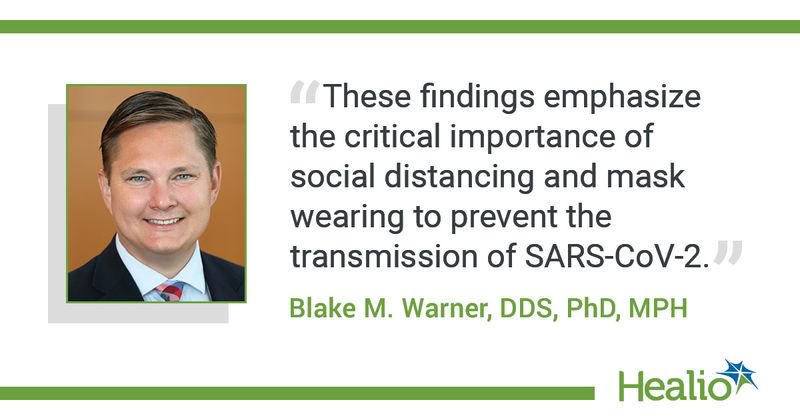SARS-CoV-2 infects mouth cells
Researchers recently found evidence that SARS-CoV-2 infects cells in the mouth, specifically in the salivary glands and tissues lining the oral cavity, suggesting that it is a site for potential infection and transmission.
It is known that the upper airways and lungs are sites of infection with the virus that causes COVID-19, but these most recent findings may explain the wide-ranging symptoms associated with the disease — including a loss of taste and smell — and how the virus is transmitted to the lungs or gastrointestinal tract through saliva, the researchers said.

In addition, “these findings emphasize the critical importance of social distancing and mask wearing to prevent the transmission of SARS‐CoV‐2,” Blake M. Warner, DDS, PhD, MPH, an assistant clinical investigator and chief of the salivary disorders unit at the National Institute of Dental and Craniofacial Research, told Healio Primary Care.
Research has established that saliva can contain high levels of SARS-CoV-2 — enough for diagnostic testing — but the question remained about where the virus in saliva comes from, according to Warner, especially in those without respiratory symptoms.
To explore the possibility that the virus could be coming from infected tissues in the mouth, Warner and colleagues studied oral tissues from healthy people. They identified RNA for two entry proteins that allow the virus to enter cells — the ACE2 receptor and the TMPRSS2 enzyme — located in the salivary glands and, to a lesser degree, the mucosa.
“The expression levels of the entry factors are similar to those in regions known to be susceptible to SARS-CoV-2 infection, such as the tissue lining the nasal passages of the upper airway,” Warner explained in a press release.
After the researchers determined that certain parts of the mouth were susceptible to infection, they looked for evidence of infection in oral tissue samples taken from patients with COVID-19. They said SARS-CoV-2 RNA was present in just over half of tissue samples taken from patients with the disease who had died. In salivary gland tissue samples from one person who had died and another living patient with COVID-19, the researchers found evidence that cells were actively making new copies of the virus, indicating infection.
The researchers said they discovered that cells shed from the mouth into saliva in patients with mild or asymptomatic disease were found to contain SARS-CoV-2 RNA, in addition to RNA for the entry proteins, indicating that oral tissues were a source of the virus in saliva.
Then, the researchers exposed saliva from eight people with asymptomatic COVID-19 to healthy cells grown in a dish, according to the press release. The saliva from two of the volunteers infected healthy cells, suggesting that even those who do not have COVID-19 symptoms might pass infectious virus to others through their saliva.
According to the release, the researchers also gathered saliva from a separate group of 35 people with asymptomatic or mild COVID-19. Of the 27 who experienced symptoms, those who were found to have the virus in their saliva were more likely to report the loss of taste and smell, possibly explaining the oral symptoms of COVID-19.
“Not only do our results illustrate a connection between reported symptoms — ie, the loss of taste and smell — and the presence of virus in the saliva, but they also demonstrate the possibility that SARS‐CoV‐2 in saliva may be source of spread within the body, such as the potential for swallowed infectious particles to be spread to the gut or lungs, or directly involved in the transmission to other people via large droplets expelled,” Warner said in the Healio interview.
Warner said the next step is to analyze additional oral tissue types, including the tongue and tonsils. Doing so will create a “comprehensive roadmap of the cell type‐specific viral vulnerabilities” to SARS-CoV-2 and other viruses — “both known and novel” — in the oral cavity, and help prepare for future pandemics and “offer targets for prevention or therapeutic intervention.”
Reference:
NIH. Scientists find evidence that novel coronavirus infects the mouth’s cells. March 25, 2021. https://www.nih.gov/news-events/news-releases/scientists-find-evidence-novel-coronavirus-infects-mouths-cells. Accessed March 31, 2021.

